Characteristics
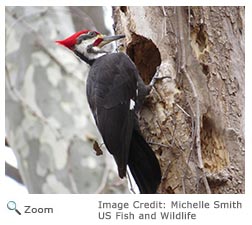 The pileated woodpecker is about 15 inches in length and is one of the largest woodpeckers found in North America. (Only the possibly extinct Ivory-billed Woodpecker in the southeastern United States and Cuba and the Imperial Woodpecker of western Mexico are larger.) The pileated woodpecker is about 15 inches in length and is one of the largest woodpeckers found in North America. (Only the possibly extinct Ivory-billed Woodpecker in the southeastern United States and Cuba and the Imperial Woodpecker of western Mexico are larger.)
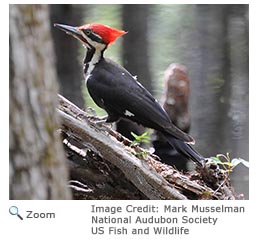 It has a black body, a red crest, white stripes on its neck and black and white stripes on its face.
It has yellow bristly feathers over its nostrils that keep out wood chips. It has a long, sticky tongue; a long, sharp pointed bill and yellow eyes. Males and females are similar, but males have a red forehead, and females have a gray to yellowish brown forehead. It has a black body, a red crest, white stripes on its neck and black and white stripes on its face.
It has yellow bristly feathers over its nostrils that keep out wood chips. It has a long, sticky tongue; a long, sharp pointed bill and yellow eyes. Males and females are similar, but males have a red forehead, and females have a gray to yellowish brown forehead.
Range
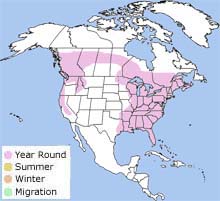 The pileated woodpecker lives in Canada from British Columbia east to Nova Scotia. It can be found in most areas of the eastern United States. It can be found in the west from Washington south to California and east to Idaho and North Dakota. The pileated woodpecker lives in Canada from British Columbia east to Nova Scotia. It can be found in most areas of the eastern United States. It can be found in the west from Washington south to California and east to Idaho and North Dakota.
Habitat
The pileated woodpecker lives in coniferous and deciduous forests.
|
|
Diet 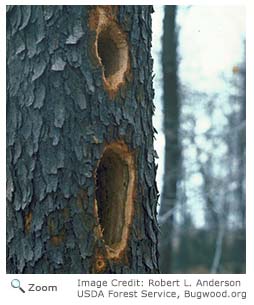 The pileated woodpecker eats insects, fruits and nuts. A large part of its diet is made up of carpenter ants and beetle larvae. It uses its sharp bill to pull bark off a tree to expose ant colonies. It uses its long, sticky tongue to poke into holes and drag out the ants. It also digs out large rectangular holes in trees to create roosting and nesting spots and to expose insects! The pileated woodpecker eats insects, fruits and nuts. A large part of its diet is made up of carpenter ants and beetle larvae. It uses its sharp bill to pull bark off a tree to expose ant colonies. It uses its long, sticky tongue to poke into holes and drag out the ants. It also digs out large rectangular holes in trees to create roosting and nesting spots and to expose insects!
Life Cycle
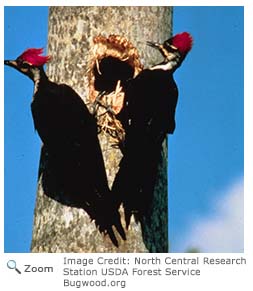 The pileated woodpecker makes its nest in a tree cavity. The female lays four eggs. Both parents incubate the eggs during the day and the male incubates the eggs at night. The chicks hatch after a little more than two weeks and fledge when they are about a month old. The pileated woodpecker makes its nest in a tree cavity. The female lays four eggs. Both parents incubate the eggs during the day and the male incubates the eggs at night. The chicks hatch after a little more than two weeks and fledge when they are about a month old.
Behavior
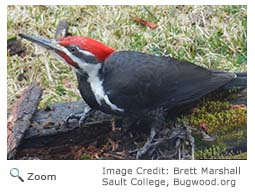 Although the pileated woodpecker is adapted to clinging to the sides of trees, it is a strong flyer and it will even sometimes hop around on the ground. The pileated woodpecker "drums" on hollow trees with its bill to claim territory.
You can pronounce pileated two ways, with a short I-sound (pill-ee-ated) or a long I-sound (pile-ee-ated).
|